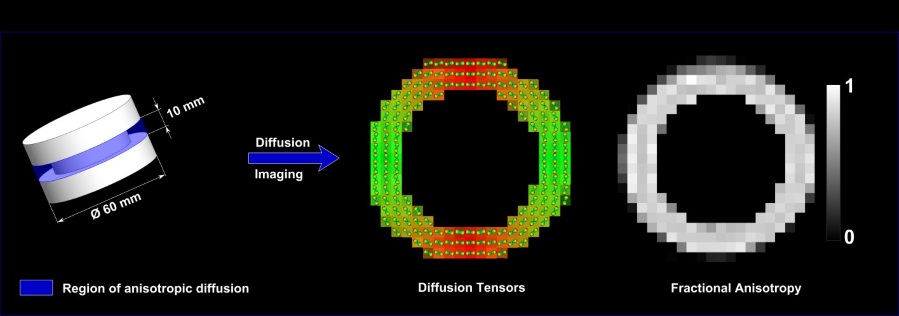DTI Basic Phantom
The DTI Single Strand phantom [1] consists of a cylindrical plastic spindle (left, white spindle) with a groove of square cross-section (left, blue area). A polyester thread is wound onto the spindle filling the grooves. Between the fibers water is embedded. This way, the restricted anisotropic diffusion in white matter of the brain is mimicked.

Standard Version
Technical specifications
- Cylindrical phantom container: Diameter: 150 mm, High: 150 mm
- Fiber strand cross-section: 10 x 10 mm2
- Outer Diameter of the spindle / fiber strand: 60 mm
- Fractional Anisotropy: 0.8
Customer-specific modifications
- FA (coming soon)
- Size of the phantom container
- Size of the spindle
- Cross-section of the fiber strand
Application examples
![]() Ground truth for validation of DTI sequences and post-processing pipelines
Ground truth for validation of DTI sequences and post-processing pipelines
![]() Quality assurance in clinical studies, multi-center studies [4-6]
Quality assurance in clinical studies, multi-center studies [4-6]
![]() Validation of advanced DTI methods and development of new reconstruction algorithms, e.g. for diffusion kurtosis imaging [3]
Validation of advanced DTI methods and development of new reconstruction algorithms, e.g. for diffusion kurtosis imaging [3]
![]() Investigation of DTI-typical artifacts and the influence of acquisition parameters [2] on the measured values for ADC and FA
Investigation of DTI-typical artifacts and the influence of acquisition parameters [2] on the measured values for ADC and FA
![]() Comparison between different MR scanners and software versions
Comparison between different MR scanners and software versions
![]() Teaching
Teaching
User reference
References: scientific articles
On the effects of dephasing due to local gradients in diffusion tensor imaging experiments: relevance for diffusion tensor imaging fiber phantoms.
How background noise shifts eigenvectors and increases eigenvalues in DTI.
Advanced fit of the diffusion kurtosis tensor by directional weighting and regularization.
Longitudinal changes in fiber tract integrity in healthy aging and mild cognitive impairment: a DTI follow-up study.
Multicenter stability of diffusion tensor imaging measures: a European clinical and physical phantom study.
Repeatability and variation of region-of-interest methods using quantitative diffusion tensor MR imaging of the brain.
